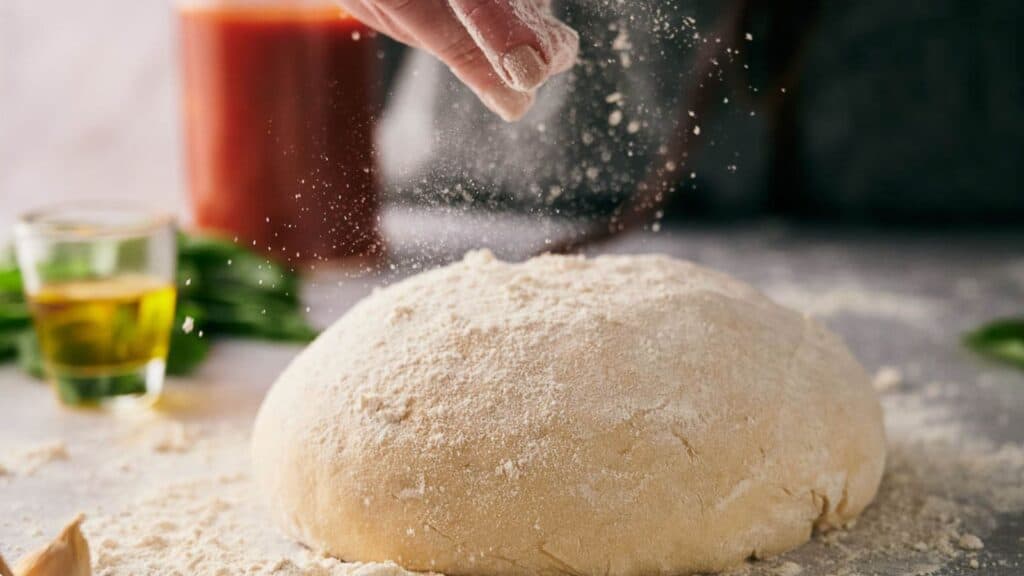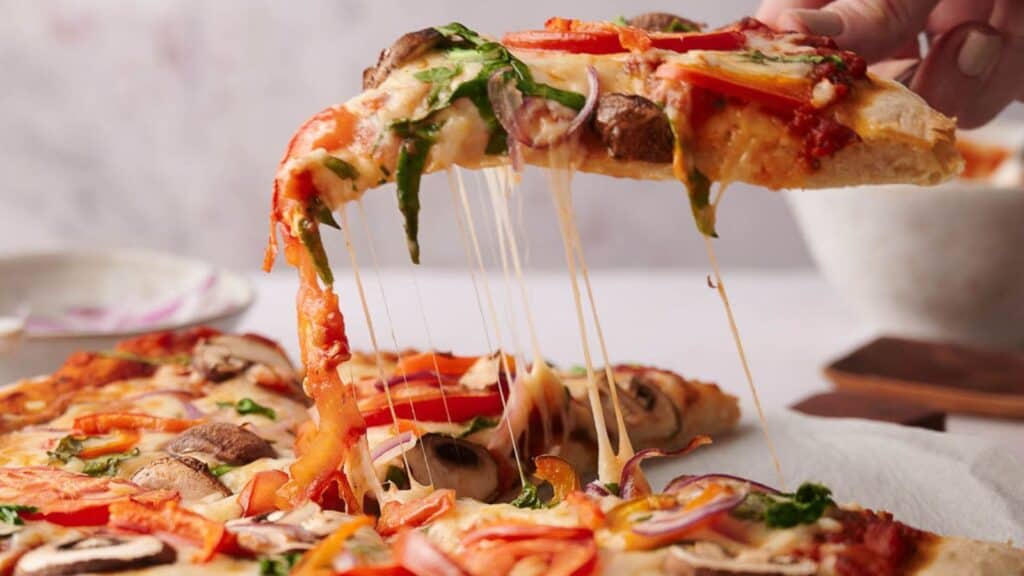Pizza is a dish that originated in Italy and has become one of the most popular foods worldwide. It is a flatbread topped with tomato sauce, cheese, and other ingredients, such as meats, vegetables, and herbs.

You can usually find a
It’s a straightforward dish with a
But you can make delicious
Making the pizza dough
See this pizza dough recipe for a complete guide, including measurements.
This
- Flour – 00
pizza flour, bread flour, or all-purpose flour - Water
- Active dry yeast
- Salt
- Extra virgin olive oil

Step-by-step instructions on how to make pizza dough
Using a stand mixer fitted with a dough hook or a mixing bowl and a rubber spatula, add yeast to a bowl of warm water and whisk.
Then add olive oil, flour, and salt and beat slowly for approximately 2 minutes.
Tip your
To knead the
Rotate the dough 90 degrees and repeat the process. This will help to stretch the gluten strands in the dough, making it more elastic and easier to work with.
Continue kneading the dough for about 5 – 10 minutes until it becomes smooth and elastic. If the dough feels too sticky, add a little more flour. If it feels too dry, add a little more water.
Use a
Once your dough is kneaded, form it into a ball and place it in a lightly oiled bowl.
Cover the bowl with a kitchen towel or plastic wrap and let the dough rise in a warm, draft-free place for at least an hour or until it has doubled.
After the dough has risen, it is ready to be rolled out and topped with your favorite ingredients, then into a
How to store pizza dough
You can store your homemade
You can also freeze the dough for up to three months. We recommend storing it in portion size so you can grab the right amount of

How to make pizza sauce
The best homemade
- Tomato-based sauce
- White sauce
- BBQ sauce
- Pesto sauce
How to make a tomato-based pizza sauce
See our delicious homemade
You’ll need these ingredients to make the sauce:
- Crushed tomatoes – San Marzano Italian tomatoes are best, as they are sweeter
- Chopped onion
- Fresh garlic
- Italian seasoning
- Red pepper flakes
- Salt & pepper
Add olive oil, garlic, tomatoes, Italian seasoning, red pepper flakes, salt, and pepper to a pan over medium heat, bring to a simmer, and then simmer for 45 minutes.
Remove the tomato mixture from the heat and let it cool. Once cool, add to a food processor or blender and blitz until the sauce is smooth.
Use immediately or store in an airtight container in the fridge for up to three days.

Pizza Toppings Ideas
There are many popular
- Cheese
- Pepperoni – veggie pepperoni is a great option for vegetarians
- Mushrooms
- Peppers
- Onions
- Olives
Choose your favorite
Tips for creating your own pizza toppings
Tips on choosing ingredients that complement each other.
For example, in a Margherita pizza, the tomatoes’ sweetness complements the cheese’s creaminess, and the basil adds a fresh herbal note.
FDL’S 75 Best Bites

Our cookbook with 75 tasty recipes will be your go-to kitchen companion for easy dinners with ad-free recipes right at your fingertips. Crafted by experienced chefs and recipe developers, this collection offers a treasure trove of tried-and-true dishes that make mealtime a breeze.
Get the Recipe: FDL’S 75 Best Bites
Layering pizza toppings
Start with the sauce: Begin by spreading a thin layer of
Use cheese as a base: Add a layer of cheese on top of the
Layer the vegetables: Add your vegetables on top of the cheese layer, and this prevents them from burning and allows them to cook evenly.
Add (veggie) meats or proteins: If you’re using (veggie) meat or protein, add it to the vegetables. This will help prevent the meat from burning and allow it to cook evenly.
Add more cheese: Add another layer of cheese on top of the toppings, and this will help to hold the toppings in place and create a delicious, gooey, cheesy layer.
Use small pieces: Chop toppings into small pieces to ensure they cook quickly and evenly and stay in place.
Spread toppings evenly: Be sure to spread them out evenly to ensure they cook evenly and don’t burn in one spot. It’ll also be much tastier when it’s sliced up.
Don’t overload: Avoid overloading the
Top with fresh herbs: After your
The best pizza cheese
- Mozzarella cheese
- Parmesan
- Provolone – not suitable for vegetarians
- Cheddar
- Gouda – be careful to buy the vegetarian version if needed
- Ricotta
- Fontina
- Pecorino Romano – choose a vegetarian Italian hard cheese alternative
The best cheese to use for different pizza styles
Thin crust
Deep dish
Neapolitan
Sicilian
Overall, the best type of cheese for any
We suggest experimenting with different cheeses to find the perfect combination for your favorite
Baking your homemade pizza
You can cook your
A
How to Bake Pizza in a Pizza Oven
Pizza ovens can reach very high temperatures; timings may vary for different brands.
Timings also vary depending on the type of toppings.
If you are baking a
Pizzas such as veggie
Use a peel to turn your
When the

How to Bake Homemade Pizza in an Oven
Preheat your oven to 500°F/260°C, and if using, place your
If baking a pesto
It may take longer if you’re cooking an olive
Watch your
When the
And if you have leftovers, you can reheat
So we’ve shown you how easy
Try our
Mandy is the enthusiastic creator of the vegetarian website Splash of Taste; she makes meat-free cooking fun and easy. When Mandy’s not cooking and writing, you’ll find her travelling, exploring countries and cuisines, and spending time with her chihuahua. Download her free 5 x Easy Vegetarian Meals eBook.